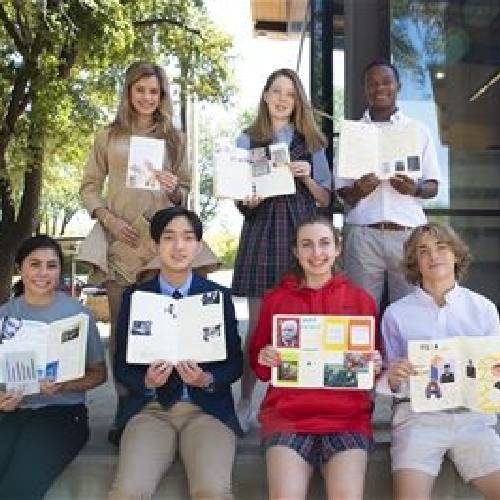March Madness at FWCD

Not everyone was caught up in the “traditional” March Madness this year! Upper School Science Teacher and Department Chair Sherri Reed and Upper School French Teacher Andréanne Annis put a spin on the fun theme with March Mammal Madness and Manie Musicale.
March Mammal Madness
This was Reed’s first year to participate in a March Madness-like activity academically. “Because of the health and safety protocols in place this year, we have not been able to do some of our typical science labs, so I wanted to try to give the ninth-graders something to remember about biology,” she noted. “Plus, I told them that they were part of this experiment … since they were the first group to do it!”
 To play and fill out brackets, Reed introduced students to the competition with a “March Mammal Madness (MMM) Explained” YouTube video. She then provided the Arizona State University Library March Mammal Madness (MMM) Library Guide for information and resources. Founded in 2013 by Dr. Katie Hinde, this annual tournament is a SIMULATED combat competition among animals. Scientific literature is cited to substantiate likely outcomes as a probabilistic function of the two species’ attributes within the battle environment. Characteristics considered in calculating battle outcomes include temperament, weaponry, armor, body mass, running speed, fight style, physiology and motivation. The bout description included scientific embedded information that allows participants to think about inter-species interactions, the importance of ecological context, how natural selection has shaped adaptations, and conservation management of endangered species.
To play and fill out brackets, Reed introduced students to the competition with a “March Mammal Madness (MMM) Explained” YouTube video. She then provided the Arizona State University Library March Mammal Madness (MMM) Library Guide for information and resources. Founded in 2013 by Dr. Katie Hinde, this annual tournament is a SIMULATED combat competition among animals. Scientific literature is cited to substantiate likely outcomes as a probabilistic function of the two species’ attributes within the battle environment. Characteristics considered in calculating battle outcomes include temperament, weaponry, armor, body mass, running speed, fight style, physiology and motivation. The bout description included scientific embedded information that allows participants to think about inter-species interactions, the importance of ecological context, how natural selection has shaped adaptations, and conservation management of endangered species.
Approximately 100 ninth-grade Biology and AP Biology students filled out brackets, along with several science teachers who wanted to play along by March 8, with a Wild Card round on that date and then first rounds on March 10 (Red, in Fur), March 11 (Tricksy Taxonomy), March 15 (Sea Besties) and March 17 (Of Myths and Monsters). “[Head of Lower School] Trey Blair and his kids were in the Upper School Science Building when I put up the large bracket bulletin board, so they played as well,” Reed noted.
The teachers shared information with students so they could make knowledgeable choices about their mammals and contest. “The kids each took one of the animals in the contest and did some simple research to create a Google slideshow which they shared with one another, so they could look up what the animal was, what adaptations it had, where it lived, etc.,” Reed said. “They also used the seeding for some events … yes, the mammals were seeded! Higher seeds were more likely to win.”
“In the first round, the higher seed had home-court advantage, which was important if you are aquatic and need to play in the ocean vs. the forest,” Reed continued. “Second rounds were varied … random locations … so not as easy. If students followed that method, then they did pretty good in round one.”
Videos were posted (featuring puppets and cartoon characters) for each round and competition so students could see if their mammal moved on or suffered defeat. “There have been a few upsets,” Reed noted. “One animal got distracted and just left the scene.”
Competitions earned points, with more points awarded as the brackets moved through the rounds. There were six total rounds, including the Elite Trait and Final Roar, before the championship. “Some students ended with some pretty high scoring brackets,” Reed said. “Not perfect...but I did have some kids with pretty high scores. We had some pretty poor brackets -- mine included because I went with the ‘cutest’ animal. Not really the best plan!
“It was a challenge for students to fill out the extensive bracket all at the beginning of the competition, especially since some of the animals were not well known and some were extinct,” Reed continued. “The fun came in watching some students climb to the top while others dropped off in points. The learning came in listening to the students’ critical analysis discussions about how the scenarios played out and if they made sense.”
In the end, the championship on March 31 pitted the Red Kangaroo versus the Harpy Eagle, with the Red Kangaroo coming out on top. Next year, Reed hopes to get the entire Upper School Science Department involved in the contest, possibly having some competitions between classes like Physics and Chemistry and Biology. She also plans to work it into the ecology unit for Biology class next year.
Manie Musicale
For a second year, Annis’ Upper School French classes took part in Manie Musicale. This French song competition aims to increase student engagement in the French language, cultural knowledge, and improve French skills using popular French songs.
Students filled out their bracket indicating what songs they felt should advance from the Sweet 16 to the next round. Then, on specific days, they voted, like 100,000 others across the country, for a battle between two songs from the francophone world. French students look forward to the reveals and feel connected to an international community through this experience. Students also discover trending songs and the meaning of their lyrics, exposing learners to the diversity of perspectives celebrated in the French-speaking world. “Teaching world languages is a step toward world peace,” Annis said, “and the Manie Musicale is a rich interactive way to connect with French-speaking artists and students.”
Developed by two French teachers in Maine in 2017, Manie Musicale had two middle schools participate. The program has grown to include more than 2,000 schools from all 50 states and 11 different countries. “Our Falcons are loving voting with thousands of students and singing the newest hits,” Annis noted. “Some featured artists have been interacting with participants on social media, on livestreams with Céphaz and Mickaël Pouvin, and a contest with 21 Juin le duo! So sweet of them to give shoutouts to Manie Musicale and answer questions from American students on an Instagram live show with Vianney and another with Keen’V. This was way beyond our expectations!” The contributions to educational activities created by participating teachers are also amazing. Annis learned a lot from this program’s collaborative nature, and she has even been acknowledged for her shared resources.
However, the sweetest music to the Upper School French teacher’s ears is hearing comments like this one from Luke Tierce ’24: “Madame, Marco Olmos ’24 was singing Tahiti in math class yesterday!” Annis also enjoyed welcoming her Falcons to a livestream with a French duet: 21 Juin le duo to take part in a challenge. Annis and her students were excited to see who won on April 6 (La Vie by Ichon Gagne) and hope to film a video that will be chosen as one of the five selected for the challenge to be included in the duet’s next video. Vive la manie musicale!
Artists communicating with FWCD students included 21 Juin le duo, Ichon Merci and Mickaêl Pouvin.






















